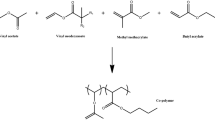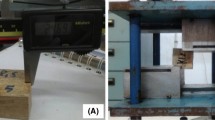Abstract
The effects of hydroxymethylated resorcinol (HMR) on the tensile shear strength of wood joints treated with montan ester wax were studied with polyvinyl acetate (PVAc) and melamine formaldehyde (MF) adhesives. Untreated specimens which were bonded with MF and PVAc had similar bond strength properties under dry conditions, but MF bonded specimens’ tensile shear strength values were higher than that of PVAc glued specimens under wet conditions. With both adhesives tested, dry tensile shear strengths of wax-treated specimens were in a comparable range to those of untreated wood, while under wet conditions the strength values of wax-treated specimens were significantly lower than those of the controls.
HMR priming increased the shear strength of PVAc bonded specimens under wet conditions and of MF-bonded specimens under dry and wet conditions. The effect on MF-bonded specimens, however, was much more pronounced under wet conditions.
Zusammenfassung
Die Wirkung von hydroxymethyliertem Resorcin (HMR) auf die Scherzugfestigkeit von mit Montanesterwachs behandelten, verklebten Holzproben wurde anhand von Bindemitteln auf Polyvinylacetat- (PVAc) und Melamin-Formaldehyd-Basis (MF) untersucht. Unbehandelte, mit MF und PVAc verklebte Proben hatten unter trockenen Bedingungen ähnliche Bindefestigkeitseigenschaften, während die Scherzugfestigkeit der mit MF verklebten Proben bei nassen Bedingungen höher war als die der PVAc-verleimten Proben. Bei beiden untersuchten Klebstoffen lag die Trockenscherzugfestigkeit der wachsbehandelten Proben in einem ähnlichen Bereich wie die der unbehandelten Proben, während die Festigkeitswerte der wachsbehandelten Proben unter nassen Bedingungen signifikant niedriger waren als die der Kontrollen.
Die Grundierung mit HMR erhöhte die Scherfestigkeit der PVAc-gebundenen Proben im nassen Zustand und die der MF-gebundenen Proben sowohl unter trockenen als auch unter nassen Bedingungen. Die Wirkung auf die MF-gebundenen Proben war jedoch unter nassen Bedingungen sehr viel ausgeprägter.
Similar content being viewed by others
References
Banks WB (1973) Water uptake by Scots pine sapwood and its restriction by the use of water repellents. Wood Sci Technol 7:271–284
Christiansen AW (1990) How overdrying wood reduces its bonding to phenol-formaldehyde adhesives: A critical review of the literature, Part 1, Physical Responses. Wood Fiber Sci 22(4):441–459
European Standard EN 302-1 (2004) Adhesives for load-bearing timber structures – Test methods – Part 1: Determination of bond strength in longitudinal tensile shear strength. German version EN 302-1:2004-10
European Standard EN 301 (2006) Adhesives, phenolic and aminoplastic, for load-bearing timber structures – Classification and performance requirements. German version EN 301:2006-9
European Standard EN 335-1 (2006) Durability of wood and wood-based products – Definition of use classes – Part 1: General. German version EN 335-1:2006-10
European standard EN 204 (2001) Classification of thermoplastic wood adhesives for non-structural applications. German version EN 204:2001-9
Gardner DJ, Frazier CE, Christiansen AW (2006) Characteristics of the wood adhesion bonding mechanism using hydroxymethyl resorcinol. Wood Adhesives 2005 [Proceedings Symposium], San Diego, CA, United States, Nov. 2–4, 2005, pp 93–97
Gardner DJ, Tze WT, Shi SQ (2001) Adhesive wettability of hydroxymethyl resorcinol (HMR) treated wood. Wood Adhesives 2000, [International Symposium], 7th, S. Lake Tahoe, NV, United States, June 22–23, 2000, pp 321–327
Hensley J, Lopez-Anido R, Gardner DJ (2000) Adhesive bonding of wood with vinyl ester resin. In: Anderson GL (ed) Proc. 23rd Annual Meeting of the Adhesion Society. The Adhesion Society, Blacksburg, VA, United States, pp 136–138
Lopez-Suevos F, Frazier CE (2006) The role of resol fortifiers in latex wood adhesives. Holzforschung 60:561–566
SAS Institute (2001) SAS/STAT release 8.2. SAS Institute, Cary
Sernek M (2002) Comparative analysis of inactivated wood surfaces. PhD thesis, Virginia Polytechnic Institute and State University. Blacksburg, VA
Son J, Gardner DJ (2004) Dimensional stability measurements of thin wood veneers using the Wilhelmy plate technique. Wood Fiber Sci 36(1):98–106
Tascioglu C (2002) Impact of preservative treatment and fungal exposure on phenolic fiber reinforced polymer (frp) composite material utilized in wood reinforcement. PhD thesis, The University of Maine, Orono
Vick C (1996) Hydroxymethylated resorcinol coupling agent for enhanced adhesion to wood. In: Christiansen AW, Conner AH (eds) Proc Wood Adhesives 1995, June 29–30 1995, Portland, OR Forest Prod Soc, Madison, WI pp 47–55
Vick C, Richter K, River BH (1996) Hydroxymethylated resorcinol coupling agent and method for bonding wood. US patent 5543487, p 17
Vick CB, Christiansen AW, Okkonen EA (1998) Reactivity of Hydroxymethylated Resorcinol Coupling Agent as It Affects Durability of Epoxy Bonds to Douglas Fir. Wood Fiber Sci 30(3):312–322
Vick CB, Okkonen EA (2000) Durability of one-part polyurethane bonds to wood improved by HMR coupling agent. For Prod J 50(10):69–75
Vick CB, Richter K, River BH, Fried Jr AR (1995) Hydroxymethylated resorcinol coupling agent for enhanced durability of bisphenol-a epoxy bonds to sitka spruce. Wood Fiber Sci 27(1):2–12
Author information
Authors and Affiliations
Corresponding author
Rights and permissions
About this article
Cite this article
Kurt, R., Krause, A., Militz, H. et al. Hydroxymethylated resorcinol (HMR) priming agent for improved bondability of wax-treated wood . Holz Roh Werkst 66, 333–338 (2008). https://doi.org/10.1007/s00107-008-0265-1
Published:
Issue Date:
DOI: https://doi.org/10.1007/s00107-008-0265-1




